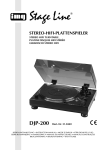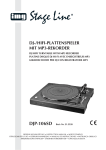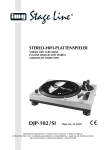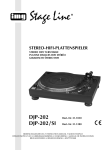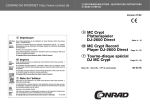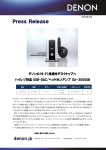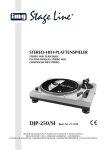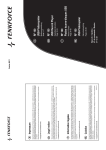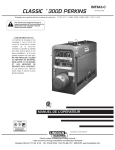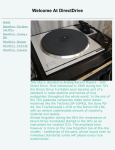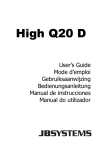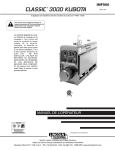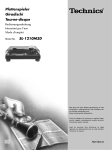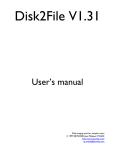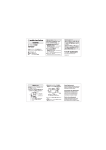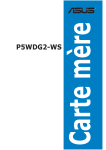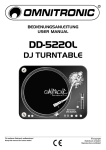Download HIFI-PLATTENSPIELER MIT USB-ANSCHLUSS
Transcript
HIFI-PLATTENSPIELER MIT USB-ANSCHLUSS HI-FI TURNTABLE WITH USB PORT PLATINE DISQUE HI-FI AVEC PORT USB GIRADISCHI HIFI CON CONNESSIONE USB DJP-300USB Bestell-Nr. 21.2600 BEDIENUNGSANLEITUNG • INSTRUCTION MANUAL • MODE D’EMPLOI • ISTRUZIONI PER L’USO VEILIGHEIDSVOORSCHRIFTEN • CONSEJOS DE SEGURIDAD • ŚRODKI BEZPIECZEŃSTWA SIKKERHEDSOPLYSNINGER • SÄKERHETSFÖRESKRIFTER • TURVALLISUUDESTA D Bevor Sie einschalten … A Wir wünschen Ihnen viel Spaß mit Ihrem neuen Gerät von „img Stage Line“. Bitte lesen Sie diese Bedienungsanleitung vor dem Betrieb gründlich durch. Nur so lernen Sie alle Funktionsmöglichkeiten kennen, vermeiden Fehlbedienungen und schützen sich und Ihr Gerät vor eventuellen Schäden durch unsachgemäßen Gebrauch. Heben Sie die Anleitung für ein späteres Nachlesen auf. We wish you much pleasure with your new “img Stage Line” unit. Please read these operating instructions carefully prior to operating the unit. Thus, you will get to know all functions of the unit, operating errors will be prevented, and yourself and the unit will be protected against any damage caused by improper use. Please keep the operating instructions for later use. Der deutsche Text beginnt auf der Seite 4. The English text starts on page 6. CH GB Before switching on … F Avant toute installation … B Nous vous souhaitons beaucoup de plaisir à utiliser cet appareil “img Stage Line”. Lisez ce mode dʼemploi entièrement avant toute utilisation. Uniquement ainsi, vous pourrez apprendre lʼensemble des possibilités de fonctionnement de lʼappareil, éviter toute manipulation erronée et vous protéger, ainsi que lʼappareil, de dommages éventuels engendrés par une utilisation inadaptée. Conservez la notice pour pouvoir vous y reporter ultérieurement. Vi auguriamo buon divertimento con il vostro nuovo apparecchio di “img Stage Line”. Leggete attentamente le istruzioni prima di mettere in funzione lʼapparecchio. Solo così potete conoscere tutte le funzionalità, evitare comandi sbagliati e proteggere voi stessi e lʼapparecchio da eventuali danni in seguito ad un uso improprio. Conservate le istruzioni per poterle consultare anche in futuro. La version française se trouve page 8. Il testo italiano inizia a pagina 10. CH NL B PL S Voor u inschakelt … I E Prima di accendere … Antes de la utilización … Wij wensen u veel plezier met uw nieuwe apparaat van “img Stage Line”. Lees de veiligheidsvoorschriften grondig door, alvorens het apparaat in gebruik te nemen. Zo behoedt u zichzelf en het apparaat voor eventuele schade door ondeskundig gebruik. Bewaar de handleiding voor latere raadpleging. Le deseamos una buena utilización para su nuevo aparato “img Stage Line”. Por favor, lea los consejos de seguridad detalladamente antes de hacer funcionar el aparato para protejerse y protejer la unidad de cualquier daño causado por una mala utilización, guarde las instrucciones para una utilización posterior. De veiligheidsvoorschriften vindt u op pagina 12. Los consejos de seguridad pueden encontrarse en la página 12. Przed uruchomieniem … DK Før du tænder … Życzymy zadowolenia z nowego produktu “img Stage Line”. Prosimy zapoznać się z informacjami dotyczącymi bezpieczeństwa przed użytkowaniem urządzenia, w ten sposób zdrowie użytkownika nie będzie zagrożone, a urządzenie nie ulegnie uszkodzeniu. Instrukcję należy zachować do wglądu. Tillykke med dit nye “img Stage Line” produkt. Læs sikkerhedsanvisningerne nøje før ibrugtagning, for at beskytte Dem og enheden mod skader, der skyldes forkert brug. Gem venligst denne betjeningsvejledning til senere brug. Informacje dotyczące bezpieczeństwa znajdują się na stronie 13. Sikkerhedsanvisningerne findes på side 13. Innan du slår på enheten … FIN Ennen kytkemistä … Vi önskar dig mycket glädje med din nya “img Stage Line” produkt. Läs igenom säkerhetsföreskrifterna innan enheten tas i bruk för att undvika skador till följd av felaktig hantering. Behåll instruktionerna för framtida bruk. Toivomme Sinulle paljon miellyttäviä hetkiä uuden “img Stage Line” laitteen kanssa. Ennen laitteen käyttöä pyydämme Sinua huolellisesti tutustumaan turvallisuusohjeisiin. Näin vältyt vahingoilta, joita virheellinen laitteen käyttö saattaa aiheuttaa. Ole hyvä ja säilytä käyttöohjeet myöhempää tarvetta varten. Säkerhetsföreskrifterna återfinns på sidan 14. Turvallisuusohjeet löytyvät sivulta 14. w w w.imgstageline.com 2 3 4 5 6 USB TO PC PHONO LINE 2 L OUT R 1 AC IN 80-260V OFF ON POWER GND 7 MOTOR OFF 8 2 9 E 4 AT 3 0 TI-SK AN 1 10 11 12 13 O 14 15 PITCH ADJ. 78 33 15 19 20 a 2.5 3 .0 1.5 2 .0 0.5 1 .0 1.0 1 .5 3.0 3 .5 3.5 0 0.5 2.0 2 .5 3 Skalenring Scale ring Anneau avec échelle Anello graduato REVERSE 22 b Antriebsriemen (b) um die Antriebsachse (a) legen Wrapping the drive belt (b) around the drive axle (a) Positionner la courroie dʼentraînement (b) autour de lʼaxe dʼentraînement (a) Sistemare la cinghia motrice (b) intorno allʼasse (a) 0 17 18 45 21 16 Tonarm ausbalancieren Balancing the tone arm Contre-balancer le bras Bilanciare il braccio Auflagegewicht einstellen Adjusting the stylus pressure Régler la force dʼappui Impostare il peso della shell D A Auf der ausklappbaren Seite 3 finden Sie alle beschriebenen Bedienelemente und Anschlüsse. CH G Stellen Sie keine mit Flüssigkeit gefüllten Gefäße, z. B. Trinkgläser, auf das Gerät. 4.2 Gegengewicht für den Tonarm und Systemträger montieren G Nehmen Sie das Gerät nicht in Betrieb und ziehen Sie sofort den Netzstecker aus der Steckdose, 1. wenn sichtbare Schäden am Gerät oder am Netzkabel vorhanden sind, 2. wenn nach einem Sturz oder Ähnlichem der Verdacht auf einen Defekt besteht, 3. wenn Funktionsstörungen auftreten. Geben Sie das Gerät in jedem Fall zur Reparatur in eine Fachwerkstatt. 1) Das Gegengewicht (8) aus einem der Verpackungsteile herausnehmen und auf das hintere Ende des Tonarms (13) stecken, bis es einrastet. Mit dem Gegengewicht wird das Auflagegewicht der Abtastnadel eingestellt ( Kapitel 4.3). 1 Übersicht der Bedienelemente und Anschlüsse 1 Ein- /Ausschalter POWER 2 Netzbuchse zum Anschluss an eine Steckdose (100 – 240 V~ / 50 – 60 Hz) über das beiliegende Netzkabel 3 USB-Anschluss (Typ B) zur Verbindung mit einem Computer Ein USB-Anschlusskabel gehört zum Lieferumfang. G Ziehen Sie den Netzstecker nie am Kabel aus der Steckdose, fassen Sie immer am Stecker an. 4.3 Auflagegewicht einstellen G Verwenden Sie für die Reinigung nur ein trockenes, weiches Tuch, niemals Wasser oder Chemikalien. 2) Die Schutzkappe für die Abtastnadel nach vorne abziehen. G Wird das Gerät zweckentfremdet, nicht richtig angeschlossen, falsch bedient oder nicht fachgerecht repariert, kann keine Haftung für daraus resultierende Sach- oder Personenschäden und keine Garantie für das Gerät übernommen werden. 4 Masseanschluss, z. B. um Brummgeräusche zu reduzieren 5 Pegelumschalter für den Audioausgang (6) beim Anschluss an einen Line-Eingang: in die Position LINE schieben beim Anschluss an einen Phono-Eingang: in die Position PHONO schieben 6 Audioausgang zum Anschluss z. B. an einen Verstärker oder an ein Mischpult 7 Taste MOTOR OFF, um die Schallplatte langsam an- oder auslaufen zu lassen Soll das Gerät endgültig aus dem Betrieb genommen werden, übergeben Sie es zur umweltgerechten Entsorgung einem örtlichen Recyclingbetrieb. 8 Gegengewicht zum Ausbalancieren des Tonarms (13) 9 Drehknopf für die Antiskating-Einstellung 10 Hebel für den Tonarmlift 11 Verriegelung für den Tonarm (13) 12 Adapter für Single-Platten 13 Tonarm 14 Regler zum Ändern der Geschwindigkeit (max. ±10 %) 15 Griffmulden zum Transport des Gerätes 16 Überwurfmutter zum Festschrauben des Systemträgers 17 Systemträger 18 Taste REVERSE zum Umschalten zwischen Vorwärts- und Rückwärtslauf 19 Start- / Stopp-Tasten 20 Nadelbeleuchtung (nach oben herausziehbar) 21 Tasten zur Wahl der Geschwindigkeit: 33 1⁄3, 45 oder 78 U / min für 78 U/min beide Tasten gleichzeitig drücken 22 Tonarmgriff 2 Hinweise für den sicheren Gebrauch Das Gerät entspricht allen erforderlichen Richtlinien der EU und ist deshalb mit gekennzeichnet. 4 3 Einsatzmöglichkeiten Der Plattenspieler DJP-300USB eignet sich sowohl für den Einsatz im privaten Bereich als auch für den professionellen DJ-Betrieb. Er ist mit einem Phono-Vorverstärker ausgestattet und kann deshalb auch an einen Line-Eingang angeschlossen werden. Zum Digitalisieren der Musik von Schallplatten lässt sich der DJP-300USB über die USBSchnittstelle an einen Computer anschließen. Zusätzlich wird eine Audio-Recording-Software benötigt. Verschiedene Programme sind als Freeware im Internet erhältlich. 4 Montage und Grundeinstellungen Der Plattenteller, der Systemträger, das Gegengewicht für den Tonarm und der Plattenspieler sind einzeln verpackt, damit beim Transport Schäden vermieden werden. Nach dem Auspacken aller Geräteteile sollte die Originalverpackung für eventuelle spätere Transporte aufbewahrt werden. Der Plattenspieler lässt sich mit den Griffmulden (15) an den Seiten bequem tragen. Den Plattenspieler auf einer ebenen, waagerechten Fläche aufstellen. 4.1 Plattenteller montieren WARNUNG Das Gerät wird mit lebensgefährlicher Netzspannung versorgt. Nehmen Sie deshalb nie selbst Eingriffe am Gerät vor. Durch unsachgemäßes Vorgehen besteht die Gefahr eines elektrischen Schlages. 1) Den Plattenteller auf die Achse des Plattenspielers stecken. Beachten Sie auch unbedingt die folgenden Punkte: 3) Der Gummi-Antriebsriemen (b) ist durch das Plattentellerloch zu sehen. Den Antriebsriemen fassen und um die Antriebsachse legen. G Das Gerät ist nur zur Verwendung im Innenbereich geeignet. Schützen Sie es vor Tropfund Spritzwasser, hoher Luftfeuchtigkeit und Hitze (zulässiger Einsatztemperaturbereich 0 – 40 °C). 2) Den Systemträger (17) aus einem der Verpackungsteile herausnehmen, auf das vordere Ende des Tonarms stecken und mit der Überwurfmutter (16) festschrauben. 2) Von Hand den Plattenteller so weit drehen, bis sich eines der zwei äußeren Löcher bei der vorderen Start- / Stopp-Taste (19) befindet und die Antriebsachse (a) des Motors zu sehen ist (Abb. 2). 4) Die beiliegende Filzmatte auf den Plattenteller legen. Durch die Filzmatte kann die Schallplatte manuell gedreht werden, wodurch sich Scratch-Effekte erzeugen lassen. 1) Den Antiskating-Drehknopf (9) auf „0“ drehen. 3) Den Tonarmlift-Hebel (10) in die vordere Position stellen. 4) Die Verriegelung (11) für den Tonarm (13) nach rechts öffnen. Den Tonarm am Griff (22) anfassen und ihn vorsichtig bis kurz vor den Plattenteller führen, sodass er sich frei nach oben und unten bewegen lässt. Vorsicht! Die Nadel nirgends anstoßen lassen. 5) Den Tonarm mit der linken Hand seitlich führen, damit die Nadel nicht am Plattenteller anstößt. Mit der rechten Hand das Gegengewicht (8) so verdrehen, dass der Tonarm genau waagerecht stehen bleibt und nicht nach oben oder unten schwingt (Abb. 3). – Schwingt der Tonarm nach oben: Das Gegengewicht entgegen dem Uhrzeigersinn drehen. – Schwingt der Tonarm nach unten: Das Gegengewicht im Uhrzeigersinn drehen. 6) Den Tonarm zurück auf die Tonarm-Halterung legen und mit der Verriegelung (11) sichern. 7) Am Gegengewicht befindet sich ein drehbarer, schwarzer Ring mit einer Skala. Den Ring, ohne das Gegengewicht zu verdrehen, auf „0“ drehen (Abb. 4), d. h. die „0“ muss oben stehen. 8) Die Skala gibt das Auflagegewicht in Gramm an. Für das mitgelieferte Abtastsystem ist ein Auflagegewicht von 3,5 g erforderlich. Dazu das Gegengewicht zusammen mit dem Ring entgegen dem Uhrzeigersinn drehen, bis die „3.5“ oben steht (Abb. 5). Für andere Abtastsysteme das Auflagegewicht einstellen, welches in den dazugehörigen technischen Daten angegeben ist. 4.4 Antiskating einstellen Die beim Abspielen einer Schallplatte auftretende Skating-Kraft zieht den Tonarm leicht in die Mitte. Durch die Antiskating-Einrichtung kann dieses kompensiert werden. Dazu den Antiskating-Drehknopf (9) so einstellen, das der Pfeil neben dem Drehknopf auf den Wert zeigt, der dem Auflagegewicht entspricht, d. h. bei dem mitgelieferten Abtastsystem auf 3.5. 5 Plattenspieler anschließen Vor dem Anschließen oder Ändern bestehender Anschlüsse den Plattenspieler ausschalten. 1) Den Stereo-Ausgang OUT (6) über ein Audiokabel mit Cinch-Steckern an den entsprechenden Eingang am Verstärker oder Mischpult anschließen: a Beim Anschluss an einen Eingang für einen Plattenspieler mit Magnetsystem den Schiebeschalter PHONO /LINE (5) in die Position PHONO stellen. b Beim Anschluss an einen Eingang für Geräte mit Line-Pegel (mögliche Beschriftung LINE, CD, AUX) den Schiebeschalter PHONO / LINE in die Position LINE stellen. 2) Sollen Musikstücke von einer Schallplatte auf einen Computer überspielt werden, den USBAnschluss USB TO PC (3) über das beiliegende USB-Kabel mit einem USB-Anschluss des Computers verbinden. Zusätzlich wird eine Audio-RecordingSoftware benötigt. Falls keine entsprechende Software auf Ihrem Computer vorhanden ist, lassen sich verschiedene Programme als Freeware aus dem Internet herunterladen. 3) Zum Schluss das beiliegende Netzkabel in die Netzbuchse AC IN (2) stecken und den Netzstecker in eine Steckdose (100 – 240 V~ / 50 – 60 Hz). 6 Bedienung 6.3 Schallplatte langsam an- oder auslaufen lassen Um eine Schallplatte langsam anlaufen und auslaufen zu lassen: 1) Die Abtastnadel über der gewünschten Stelle der Schallplatte positionieren, aber noch nicht mit dem Hebel (10) für den Tonarmlift absenken. 2) Eine der Tasten (19) drücken, damit der Plattenteller rotiert. 3) Den Plattentellermotor mit der Taste MOTOR OFF (7) ausschalten. Die LED der Taste erlischt. 4) Die Abtastnadel mit dem Hebel (10) für den Tonarmlift auf die Schallplatte absenken. 5) Die Schallplatte mit der Taste MOTOR OFF anlaufen lassen. 6) Zum langsamen Auslaufen der Schallplatte die Taste MOTOR OFF an gewünschter Stelle erneut betätigen. 6.1 Schallplatte abspielen 1) Die Schutzkappe für die Abtastnadel nach vorne abziehen. 6.4 Umschalten Vor- / Rückwärtslauf 2) Den Plattenspieler mit dem Schalter POWER (1) einschalten. Die LED der Taste MOTOR OFF (7), die Nadelbeleuchtung (20) und die LED der Taste „33“ (21) leuchten. Als besonderen Effekt bietet der DJP-300USB die Möglichkeit, die Drehrichtung des Plattentellers umzuschalten. Dazu die Taste REVERSE (18) kurz drücken. Bei eingeschaltetem Rückwärtslauf leuchtet die rote LED über der Taste. 3) Zur Wahl der Geschwindigkeit die entsprechende Taste (21) drücken: Hinweis: Der Plattenteller muss rotieren, sonst hat die Taste REVERSE keine Funktion. 7.3 Filzmatte Sollte die beiliegende Filzmatte einmal verlegt oder verschlissen sein, kann eine neue Matte unter der Bezeichnung DJP-2M von „img Stage Line“ bestellt werden. 8.1 Pflege Das Plattenspielergehäuse mit einem trockenen, weichen Tuch oder einem leicht angefeuchteten Lappen (nicht tropfnass!) abwischen. Keinen Alkohol, keine Chemikalien oder scharfe Reinigungsmittel verwenden! Zum Entstauben der Abtastnadel und Schallplatten ist im Fachhandel entsprechendes Zubehör erhältlich, z. B. die Carbonfaser-Plattenbürste DC-100 von MONACOR. 8.2 Transport Wollen Sie den Plattenspieler versenden, so achten Sie darauf, dass der Plattenteller und alle anderen Baugruppen des Gerätes nur original verpackt oder extra transportgesichert verschickt werden. Schäden, die durch einen unsachgemäß lose verpackten Plattenteller (z. B. Plattenteller nicht von der Achse genommen und nicht gesichert o. Ä.) verursacht werden, unterliegen nicht der Garantie. Entsprechende Reparaturen sind deshalb kostenpflichtig! 7 Zubehör 1) Die Schutzkappe für die Abtastnadel aufstecken. Zur Anzeige der gewählten Geschwindigkeit leuchtet die jeweilige LED über der Taste. 7.1 Ersatz-Tonabnehmersystem und Ersatz-Abtastnadel 2) Den Tonarm (13) mit der Verriegelung (11) sichern. Bei Bedarf kann das Tonabnehmersystem oder die Abtastnadel leicht ausgewechselt werden. Im Fachhandel sind entsprechende Ersatzteile erhältlich, z. B. von MONACOR das Tonabnehmer-Magnetsystem EN-24 und die dazu passende Ersatznadel EN-24SP. 3) Das Gegengewicht (8) für den Tonarm abschrauben. 5) Die Verriegelung (11) für den Tonarm (13) nach rechts öffnen. Zum Anheben des Tonarms den Hebel (10) für den Tonarm-Lift in die hintere Position stellen. 6) Den Tonarm am Griff (22) anfassen und die Abtastnadel über dem Anfang bzw. der gewünschten Stelle der Schallplatte positionieren. Den Hebel (10) für den Tonarm-Lift in die vordere Position stellen. Der Tonarm senkt sich langsam auf die Schallplatte. 7) Eine der Start-/Stopp-Tasten (19) drücken. Der Plattenteller beginnt zu rotieren. Während des Abspielens kann die Platte für eine Unterbrechung mit einer der Tasten an jeder Stelle gestoppt und wieder gestartet werden. 8) Zum Beenden des Abspielens den Tonarm mit dem Tonarmlift-Hebel (10) anheben und ihn per Hand auf den Tonarm-Halter zurückführen. Den Plattenteller mit einer der Tasten stoppen. 9) Nach dem Gebrauch des Plattenspielers den Tonarm mit der Verriegelung (11) sichern und das Gerät mit dem Schalter POWER (1) ausschalten. A CH 8 Wartung für 33 1⁄3 U / min die linke Taste „33“ für 45 U / min die rechte Taste „45“ für 78 U / min beide Tasten „33“ und „45“ 4) Die Schallplatte auflegen. Bei Single-Platten den Adapter (12) mit auflegen. Der Adapter lässt sich leicht aus seiner Mulde entnehmen, indem man auf seine hintere Kante drückt. D Für den Versand unbedingt beachten: 1) Zum Wechseln der Abtastnadel die weiße Nadelhalterung nach unten kippen und abziehen. Die neue Nadel auf das Abtastsystem stecken. 2) Zum Wechsel des Tonabnehmersystems die Überwurfmutter (16) losschrauben und den Systemträger (17) vom Tonarm (13) abziehen. 4) Den Plattenteller von der Achse abnehmen, einzeln verpacken und gegen Verrutschen sichern. 5) Am besten den Original-Verpackungskarton verwenden. 9 Technische Daten Plattenteller: . . . . . . . . . . . ∅ 332 mm, Aluminiumguss 3) Das Tonabnehmersystem vom Träger abschrauben und die Anschlussdrähte abziehen. Antrieb: . . . . . . . . . . . . . . . Riemenantrieb 4) Das neue Tonabnehmersystem am Träger festschrauben und die Drähte wie folgt aufstecken: Anlaufdrehmoment: . . . . . 0,07 Nm blau weiß grün rot linker Kanal Pluspol linker Kanal Minuspol rechter Kanal Pluspol rechter Kanal Minuspol 5) Nach dem Austausch des Tonabnehmersystems das Auflagegewicht und den Antiskating-Wert neu einstellen ( Kap. 4.3 und 4.4). Geschwindigkeiten: . . . . . . 33 1⁄3, 45, 78 U / min Geschwindigkeitsänderung: ±10 % Anlauflaufzeit: . . . . . . . . . . < 1 s Gleichlaufschwankungen: . < 0,3 % Stromversorgung: . . . . . . . 100 – 240 V~, 50 – 60 Hz Leistungsaufnahme: . . . . . max. 15 VA Einsatztemperatur: . . . . . . 0 – 40 °C Abmessungen (B × H × T): 480 × 135 × 370 mm Gewicht: . . . . . . . . . . . . . . 3,7 kg 7.2 Ersatz-Systemträger 6.2 Geschwindigkeit verändern Bei Bedarf kann die Geschwindigkeit des Plattenspielers und dadurch die Tonhöhe („pitch“) eines Musikstückes mit dem Regler PITCH ADJ. (14) um bis zu 10 % erhöht oder verringert werden. In der Mittelstellung (Regler rastet ein) ist die Normalgeschwindigkeit eingestellt, d. h. exakt 33 1⁄3 U / min, 45 U / min oder 78 U / min. Ein Ersatz-Systemträger (z. B. der Systemträger EN-120 von MONACOR) komplett mit einem Tonabnehmersystem ermöglicht bei Bedarf einen schnellen Austausch. Der Systemträger (16) lässt sich einfach durch Ab- und Anschrauben auswechseln. Anschließend das Auflagegewicht und den Antiskating-Wert neu einstellen ( Kap. 4.3 und 4.4). Änderungen vorbehalten. Diese Bedienungsanleitung ist urheberrechtlich für MONACOR ® INTERNATIONAL GmbH & Co. KG geschützt. Eine Reproduktion für eigene kommerzielle Zwecke – auch auszugsweise – ist untersagt. 5 GB All operating elements and connections described can be found on the fold-out page 3. 1 Operating Elements and Connections G Never pull the mains cable to disconnect the mains plug from the socket, always seize the plug. G For cleaning only use a dry, soft cloth; never use water or chemicals. G No guarantee claims for the unit and no liability for any resulting personal damage or material damage will be accepted if the unit is used for other purposes than originally intended, if it is not correctly connected or operated, or if it is not repaired in an expert way. 1 POWER switch 2 Mains jack for connection to a mains socket (100 – 240 V~ / 50 – 60 Hz) via the mains cable provided 3 USB port (type B) to connect a computer A USB connection cable is supplied with the turntable. 4 Ground connection, e. g. to reduce hum noise 5 Level selector switch for the audio output (6) when connecting a line input: set the switch to the position LINE when connecting a phono input: set the switch to the position PHONO 6 Audio output, e. g. to connect an amplifier or a mixer 7 Button MOTOR OFF to start or stop the record slowly 8 Counterweight to balance the tone arm (13) 9 Rotary knob for anti-skating adjustment 10 Lever for the tone arm lift 11 Lock for the tone arm (13) 12 Adapter for single records G Important for U. K. Customers! The wires in this mains lead are coloured in accordance with the following code: blue = neutral brown = live As the colours of the wires in the mains lead of this appliance may not correspond with the coloured markings identifying the terminals in your plug, proceed as follows: 1. The wire which is coloured blue must be connected to the terminal which is marked with the letter N or coloured black. 2. The wire which is coloured brown must be connected to the terminal which is marked with the letter L or coloured red. If the unit is to be put out of operation definitively, take it to a local recycling plant for a disposal which will not be harmful to the environment. 13 Tone arm 14 Control to change the speed (±10 % max.) 15 Recessed handles for carrying the turntable 16 Cap nut to fasten the headshell 17 Headshell 18 Button REVERSE to switch between forward and reverse mode 19 Start / Stop buttons 20 Target light (disconnectable plug) 21 Buttons to select the speed: 33 1⁄3, 45 or 78 rpm for 78 rpm, press both buttons at the same time 22 Handle of tone arm 2 Safety Notes This unit corresponds to all required directives of the EU and is therefore marked with . WARNING The unit uses dangerous mains voltage. Leave servicing to skilled personnel only. Inexpert handling or modification of the unit may result in electric shock. Please observe the following items in any case: G G G 6 The unit is suitable for indoor use only. Protect it against dripping water and splash water, high air humidity and heat (admissible ambient temperature range 0 – 40 °C). Do not place any vessel filled with liquid on the unit, e. g. a drinking glass. Do not operate the unit and immediately disconnect the mains plug from the socket 1. if the unit or the mains cable is visibly damaged, 2. if a defect might have occurred after the unit was dropped or suffered a similar accident, 3. if malfunctions occur. In any case the unit must be repaired by skilled personnel. 3 Applications The turntable DJP-300USB is suited both for private applications and for professional DJ applications. It is equipped with a phono preamplifier and therefore also allows connection to a line input. For digitizing records, the DJP-300USB has a USB interface to connect a computer. An audio recording software will also be required. Various programs are available as freeware on the Internet. 4 Mounting and Basic Adjustments The turntable platter, the headshell, the counterweight for the tone arm and the turntable are wrapped individually to prevent damage during transport. After unpacking all parts of the turntable, it is recommended to save the original packing material for any future transport. With the recessed handles (15) on its sides, the turntable can be carried conveniently. Place the turntable on a flat, horizontal surface. 4.1 Assembling the turntable 4.2 Mounting the counterweight for the tone arm and the headshell 1) Remove the counterweight (8) from its wrapping and put it on the rear end of the tone arm (13) until it engages. The counterweight is used to adjust the stylus pressure ( chapter 4.3). 2) Remove the headshell (17) from its wrapping, put it on the front end of the tone arm and fasten it with the cap nut (16). 4.3 Adjusting the stylus pressure 1) Set the anti-skating knob (9) to “0”. 2) Remove the protective cap from the stylus towards the front. 3) Set the tone arm lever (10) to the front position. 4) Open the lock (11) for the tone arm (13) to the right. Seize the handle (22) of the tone arm and carefully lead it just before the turntable platter so that it will move up and down freely. Caution! The stylus must not hit against anything. 5) With your left hand, lead the tone arm to the side so that the stylus will not hit the turntable platter. With your right hand, turn the counterweight (8) so that the tone arm will stay exactly in a horizontal position without moving up or down (fig. 3). – If the tone arm moves upwards, turn the counterweight counter-clockwise. – If the tone arm moves downwards, turn the counterweight clockwise. 6) Return the tone arm to it support and secure it with the lock (11). 7) The counterweight is provided with a black rotary scale ring. Without turning the counterweight, set the ring to “0” (fig. 4), i.e. the “0” must be at the top. 8) The scale indicates the stylus pressure in grams. For the phono cartridge system provided, a stylus pressure of 3.5 g is required. For this purpose, turn the counterweight including the ring counter-clockwise until “3.5” is at the top (fig.5). For other phono cartridge systems, adjust the stylus pressure according to the corresponding specifications. 4.4 Anti-skating adjustment The skating force occurring when playing a record will slightly pull the tone arm towards the centre. This will be compensated by the antiskating adjustment. For this purpose, turn the anti-skating knob (9) so that the arrow next to the rotary knob will point to the value corresponding to the stylus pressure, i. e. 3.5 for the phono cartridge system provided. 1) Put the turntable platter on the axle of the turntable. 2) Turn the platter with your hand until one of the two outer holes is near the front Start / Stop button (19) and the drive axle (a) of the motor is visible (fig. 2). 3) The rubber drive belt (b) is visible through the hole in the platter. Seize the drive belt and wrap it around the drive axle. 4) Put the felt slipmat supplied on the platter. Due to the felt slipmat, scratch effects will be created when the record is turned manually. 5 Connecting the Turntable Switch off the turntable before making connections or changing any existing connections. 1) Connect the stereo output OUT (6) via an audio cable with RCA plugs to the corresponding input on the amplifier or mixer: a When connecting an input for a turntable with magnetic system, set the sliding switch PHONO / LINE (5) to the position PHONO. b When connecting an input for units with line level (possibly marked LINE, CD, AUX), set the sliding switch PHONO / LINE to the position LINE. 2) For transferring music pieces from a record to a computer, connect the USB port USB TO PC (3) via the USB cable provided to a USB port of the computer. An audio recording software will also be required. If there is no corresponding software on your computer, various programs are available as freeware on the Internet for download. 6.3 Slowly starting or stopping a record 3) Finally connect the mains cable provided to the mains jack AC IN (2), then connect the mains plug to a mains socket (100 – 240 V~ / 50 – 60 Hz). 3) Switch off the motor of the turntable platter with the button MOTOR OFF (7). The LED of the button will be extinguished. 8 Maintenance 4) Lower the stylus onto the record with the lever (10) for the tone arm lift. 8.1 Cleaning 6 Operation 6.1 Playing a record 1) Remove the protective cap from the stylus towards the front. 2) Switch on the turntable with the POWER switch (1). The LED of the button MOTOR OFF (7), the target light (20) and the LED of the button “33” (21) will light up. 3) To select the speed, press the corresponding button (21): To slowly start or stop a record: 1) Position the stylus above the desired spot of the record without lowering it with the lever (10) for the tone arm lift. 2) Press one of the buttons rotation of the turntable. (19) to start the 5) Slowly start the record with the button MOTOR OFF. 6) To slowly stop the record, actuate the button MOTOR OFF again at the desired spot. 6.4 Changing between forward and reverse mode As a special effect, the DJP-300USB will be capable of changing the sense of rotation of the turntable platter. For this purpose, shortly press the button REVERSE (18). The red LED above the button will light up if the reverse mode is activated. for 33 1⁄3 rpm, press the left button “33” for 45 rpm, press the right button “45” for 78 rpm, press both buttons “33” and “45” Note: The turntable platter must be in rotation, otherwise the button REVERSE will be without function. To indicate the speed selected, the corresponding LED above the button will light up. 7 Accessories 4) Put on the record. For single records, use the adapter (12). It is easy to remove the adapter from its recess: simply press its rear edge. 5) Open the lock (11) for the tone arm (13) to the right. To lift the tone arm, set the tone arm lift to the rear position. 6) Seize the tone arm on its handle (22) and position the stylus above the beginning or the desired spot on the record. Set the lever (10) for the tone arm lift to the front position. The tone arm will slowly be lowered onto the record. 7) Press one of the Start / Stop buttons (19). The turntable platter will start rotating. To stop and restart the record at any time while playing, use one of the buttons . 8) To stop playing, lift the tone arm with the lever of the tone arm lift (10) and return it to the tone arm support with your hand. Stop the turntable platter with one of the buttons . 9) After using the turntable, secure the tone arm with the lock (11) and switch off the turntable with the POWER switch (1). 6.2 Changing the speed If required, it will be possible to increase or decrease the speed of the turntable and thus the pitch of a music piece with the control PITCH ADJ. (14) by up to 10 %. In mid-position (control will engage), the normal speed is adjusted, i. e. precisely 33 1⁄3 rpm, 45 rpm or 78 rpm. 7.1 Replacement phono cartridge system and replacement stylus The phono cartridge system or the stylus is easily replaced, if required. The corresponding replacement parts are available from your retailer, e. g. the magnetic phono cartridge system EN-24 and the matching replacement stylus EN-24SP from MONACOR. 1) To replace the stylus, tilt the white stylus support downwards and remove it. Put the new stylus on the phono cartridge system. 2) To replace the phono cartridge system, unscrew the cap nut (16) and remove the headshell (17) from the tone arm (13). replaced by screwing it off and on. Then readjust the counterweight and the anti-skating value ( chapters 4.3 and 4.4). 7.3 Felt slipmat If the felt slipmat provided is lost or worn, a new mat (DJP-2M) is available from “img Stage Line”. Clean the turntable housing with a soft cloth, dry or slightly damp (not dripping wet). Do not use any alcohol, chemicals or aggressive detergents! To dust the stylus and the records, the corresponding accessories will be available from your retailer, e. g. the carbon fibre record cleaning brush DC-100 from MONACOR. 8.2 Transport When dispatching the turntable, make sure that the turntable and all other components of the unit are wrapped in their original packaging or that they are especially secured for transport. Any damage due to incorrect transport of the turntable (e. g. platter not removed from the axle, not secured or the like) will not be covered by the guarantee and any resulting repairs will be charged! When dispatching the turntable, always proceed as follows: 1) Put the protective cap on the stylus. 2) Secure the tone arm (13) with the lock (11). 3) Unscrew the counterweight (8) for the tone arm. 4) Remove the turntable platter from the axle, wrap it separately and secure it against slipping. 5) It is recommended to use the original packing box. 9 Specifications Turntable platter: . . . . . . . . ∅ 332 mm, cast aluminium 3) Unscrew the phono cartridge system from the support and remove the connecting wires. Drive: . . . . . . . . . . . . . . . . belt drive 4) Screw the new phono cartridge system onto the support and connect the wires as follows: Change of speed: . . . . . . . ±10 % blue left channel, positive pole white left channel, negative pole green right channel, positive pole red right channel, negative pole 5) After replacing the phono cartridge system, readjust the counterweight and the anti-skating value ( chapters 4.3 and 4.4). GB Speeds: . . . . . . . . . . . . . . . 33 1⁄3, 45, 78 rpm Starting torque: . . . . . . . . . 0.07 Nm Starting time: . . . . . . . . . . . < 1 second Wow and flutter: . . . . . . . . < 0.3 % Power supply: . . . . . . . . . . 100 – 240 V~, 50 – 60 Hz Power consumption: . . . . . 15 VA max. Ambient temperature. . . . . 0 – 40 °C 7.2 Replacement headshell Dimensions (W × H × D): . 480 × 135 × 370 mm A replacement headshell (e. g. the headshell EN-120 from MONACOR) including a phono cartridge system will allow quick replacement, if necessary. The headshell (16) is easily Weight: . . . . . . . . . . . . . . . 3.7 kg Subject to technical modification. All rights reserved by MONACOR ® INTERNATIONAL GmbH & Co. KG. No part of this instruction manual may be reproduced in any form or by any means for any commercial use. 7 F B Ouvrez le présent livret page 3, dépliable, de manière à visualiser les éléments et branchements. CH G En aucun cas, vous ne devez poser dʼobjet contenant du liquide ou un verre sur lʼappareil. 4.2 Montage du contrepoids pour le bras et du porte cellule G Ne faites jamais fonctionner lʼappareil et débranchez-le immédiatement lorsque : 1. des dommages visibles apparaissent sur lʼappareil ou sur le cordon secteur 2. après une chute ou accident similaire, vous avez un doute au sujet de lʼétat de lʼappareil. 3. des dysfonctionnements apparaissent. Dans tous les cas, les dommages doivent être réparés par un technicien spécialisé. 1) Retirez le contrepoids (8) de son emballage et placez-le sur lʼextrémité arrière du bras (13) jusquʼà ce quʼil sʼencastre. Avec le contrepoids, vous pouvez régler la force dʼappui du bras de lecture ( chapitre 4.3). Ne débranchez jamais lʼappareil en tirant sur le cordon secteur, retirez toujours le cordon secteur en tirant la fiche. 1) Mettez le bouton dʼanti-skating (9) sur “0”. 1 Eléments et branchements 1 Interrupteur POWER Marche /Arrêt 2 Prise secteur à relier à une prise 100 – 240 V~ / 50 – 60 Hz via le cordon secteur livré 3 Prise USB (type B) pour relier à un ordinateur Un cordon USB de branchement est livré avec la platine disque. G 4 Borne masse par exemple pour diminuer les ronflements 5 Sélecteur de niveau pour la sortie audio (6) branchement à une entrée Ligne : mettez-le sur la position LINE branchement à une entrée Phono : mettez-le sur PHONO 6 Sortie audio pour brancher à lʼentrée ligne par exemple dʼun amplificateur ou dʼune table de mixage 7 Touche MOTOR OFF pour faire débuter ou arrêter le disque lentement 8 Contrepoids pour contre-balancer le bras (13) 9 Bouton rotatif pour le réglage de lʼanti-skating 10 Levier pour le lève-bras G Pour nettoyer lʼappareil, utilisez uniquement un chiffon doux et sec, en aucun cas de produits chimiques ou dʼeau. G Nous déclinons toute responsabilité en cas de dommages matériels ou corporels résultants si lʼappareil est utilisé dans un but autre que celui pour lequel il a été conçu, sʼil nʼest pas correctement branché ou utilisé ou sʼil nʼest pas réparé par une personne habilitée, en outre, la garantie deviendrait caduque. Lorsque lʼappareil est définitivement retiré du service, vous devez le déposer dans une usine de recyclage adaptée pour contribuer à son élimination non polluante. 11 Verrouillage pour le bras (13) 12 Adaptateur pour disques Single 45 tours 13 Bras 14 Réglage pour modifier la vitesse (±10% max.) 15 Encoches pour transporter la platine 16 Ecrou vissant pour visser le support du porte cellule 17 Porte cellule 18 Touche REVERSE pour commuter entre lecture avant et lecture arrière 3 Possibilités dʼutilisation La platine disque DJP-300USB est bien adaptée pour une utilisation dans le domaine privé et pour un fonctionnement DJ professionnel. Elle est équipée dʼun préamplificateur Phono et peut donc être reliée à une entrée Ligne. Pour digitaliser la musique de disques, on peut relier la DJP-300USB via lʼinterface USB à un ordinateur. Un logiciel dʼenregistrement audio est nécessaire. Différents programmes sont disponibles sur Internet en freeware. 19 Touches Marche /Arrêt 20 Eclairage aiguille (retirable vers le haut) 21 Touches de sélection de la vitesse : 33 1⁄3, 45 ou 78 tours / mn Pour les disques 78 tr / mn, appuyez simultanément sur les deux touches. 22 Poignée du bras 2 Conseils dʼutilisation et de sécurité Cet appareil répond à toutes les directives nécessaires de lʼUnion européenne et porte donc le symbole . AVERTISSEMENT Cet appareil est alimenté par une tension dangereuse. Ne touchez jamais lʼintérieur de lʼappareil car, en cas de mauvaise manipulation, vous pourriez subir une décharge électrique. Respectez scrupuleusement les points suivants: G 8 Lʼappareil nʼest conçu que pour une utilisation en intérieur. Protégez-le de tout type de projections dʼeau, des éclaboussures, dʼune humidité élevée de lʼair et de la chaleur (plage de température de fonctionnement autorisée : 0 — 40 °C). 4 Montage et réglages de base Le plateau, le porte cellule, le contrepoids pour le bras et la platine disque sont emballés séparément de manière à éviter tout dommage pendant le transport. Lorsque vous avez déballé tous les éléments, il est recommandé de conserver les emballages pour tout transport ultérieur. Vous pouvez transporter facilement le plateau grâce aux encoches (15) sur les côtés. Positionnez la platine disque sur une surface plane et horizontale. 4.1 Montage du plateau 1) Placez le plateau sur lʼaxe de la platine disque. 2) Tournez le plateau avec la main jusquʼà ce quʼun des deux trous extérieurs se trouve au niveau de la touche marche / arrêt (19) avant et que lʼaxe dʼentraînement (a) du moteur soit visible (schéma 2). 3) Vous pouvez voir la courroie caoutchouc dʼentraînement (b) via le trou du plateau. Saisissez la courroie et positionnez-la autour de lʼaxe dʼentraînement. 4) Placez la feutrine livrée sur le plateau. Grâce à la feutrine, vous pouvez tourner manuellement le disque en produisant des effets Scratch. 2) Retirez le porte cellule (17) de son emballage, positionnez-le sur lʼextrémité avant du bras et vissez avec lʼécrou vissant (16). 4.3 Réglage du contrepoids 2) Retirez le cache de protection pour lʼaiguille en le poussant vers lʼavant. 3) Mettez le levier du bras (10) sur la position avant. 4) Ouvrez le verrouillage (11) du bras (13) vers la droite. Saisissez le bras par la poignée (22) et amenez-le avec précaution jusque devant le plateau de telle sorte quʼil puisse se déplacer librement vers le haut et le bas. Attention ! Ne faites jamais toucher lʼaiguille. 5) Avec la main gauche, déplacez le bras latéralement pour que lʼaiguille ne touche pas le plateau. Avec la main droite, tournez le contrepoids (8) de telle sorte que le bras reste stable à lʼhorizontale et ne penche pas vers le bas ou ne se lève vers le haut (schéma 3). – Si le bras se lève vers le haut : tournez le contrepoids dans le sens inverse des aiguilles dʼune montre. – Si le bras penche vers le bas : tournez le contrepoids dans le sens des aiguilles dʼune montre. 6) Replacez le bras sur le support et fermez le verrouillage (11). 7) Un anneau noir rotatif avec une échelle se trouve sur le contrepoids. Tournez lʼanneau sur “0” sans tourner le contrepoids (schéma 4), cʼest-à-dire que “0“ doit être en haut. 8) Lʼéchelle donne la force dʼappui en grammes. Pour la cellule livrée, une force dʼappui de 3,5 g est nécessaire. Pour ce faire, tournez le contrepoids avec lʼanneau, dans le sens inverse des aiguilles dʼune montre jusquʼà ce que “3.5” soit en haut (schéma 5). Pour les autres cellules, réglez la force dʼappui selon les caractéristiques techniques correspondantes. 4.4 Réglage de lʼanti-skating Lors de la lecture dʼun disque, la force Skating est créée et tire le bras légèrement vers le centre. Le réglage dʼanti-skating vise à compenser ce problème. Tournez le bouton dʼanti-skating (9) de telle sorte que la flèche à côté du bouton indique la valeur correspondant à la force dʼappui, cʼest-à-dire pour la cellule livrée, 3.5. 5 Branchements de la platine disque Avant dʼeffectuer ou de modifier les branchements, éteignez la platine disque. 1) Reliez la sortie stéréo OUT (6) via un cordon audio avec fiches RCA mâles à lʼentrée correspondante sur lʼamplificateur ou la table de mixage : a Pour un branchement à une entrée pour une platine disque avec système magné- tique, réglez le sélecteur PHONO / LINE (5) sur la position PHONO. b Pour un branchement sur une entrée pour appareils à niveau ligne (repère possible LINE, CD, AUX), réglez le sélecteur PHONO / LINE sur la position LINE. 2) Si des morceaux de musique dʼun disque doivent être transférés sur un ordinateur, reliez le port USB TO PC (3) via le cordon USB livré à un port USB de lʼordinateur. Un logiciel audio dʼenregistrement est nécessaire ; si aucun logiciel adéquat nʼest sur votre ordinateur, différents programmes sont disponibles sur Internet en freeware. 3) Reliez enfin le cordon secteur livré à la prise AC IN (2) puis reliez lʼautre extrémité à une prise secteur 100 – 240 V~ / 50 – 60 Hz. 6.3 Faire débuter ou arrêter lentement un disque 8 Entretien F Pour faire débuter ou arrêter lentement un disque : 8.1 Nettoyage CH 1) Positionnez lʼaiguille au-dessus de lʼendroit voulu du disque, nʼabaissez pas encore avec le levier (10) pour le lève-bras. 2) Appuyez sur une des touches que le plateau tourne. (19) pour 3) Eteignez le moteur du plateau avec la touche MOTOR OFF (7), la LED de la touche sʼéteint. 4) Abaissez lʼaiguille avec le levier (10) pour le lève-bras sur le disque. 5) Faites démarrer le disque avec la touche MOTOR OFF. 6) Pour un arrêt lent du disque, activez à nouveau la touche MOTOR OFF à lʼendroit voulu. 6 Utilisation 6.4 Commutation lecture avant / arrière 6.1 Lecture dʼun disque 1) Retirez le cache de protection de lʼaiguille en tirant vers lʼavant. 2) Allumez la platine disque avec lʼinterrupteur POWER (1), la LED de la touche MOTOR OFF (7), lʼéclairage de lʼaiguille (20) et la LED de la touche “33” (21) brillent. La DJP-300USB propose comme effet particulier de pouvoir inverser le sens de rotation du plateau ; appuyez brièvement sur la touche REVERSE (18). Lorsque la lecture arrière est activée, le LED rouge au-dessus de la touche brille. Remarque : Le plateau doit tourner, sinon la touche REVERSE nʼa aucune fonction. 3) Pour sélectionner la vitesse, appuyez sur la touche correspondante (21) : 1 pour 33 ⁄3 tours / mn : touche gauche “33” pour 45 tours / mn : touche droite “45” pour 78 tours / mn : touches “33” et “45” La LED correspondante au-dessus de la touche brille indiquant la vitesse sélectionnée. 4) Positionnez le disque ; pour des 45 tours, mettez lʼadaptateur (12) en place. On peut le retirer facilement de son encoche en appuyant sur son arête arrière. 5) Ouvrez le verrouillage (11) pour le bras (13) vers la droite. Pour soulever le bras, mettez le levier (10) pour le lève-bras sur la position arrière. 6) Saisissez le bras par la poignée (22) et positionnez lʼaiguille au-dessus du début du disque ou à lʼendroit voulu sur le disque. Mettez le levier (10) pour le lève-bras sur la position avant, le bras descend lentement sur le disque. 7) Appuyez sur une des touches Marche /Arrêt (19). Le plateau commence à tourner. Pendant la lecture on peut arrêter le disque à tout moment avec une des touches pour une interruption puis redémarrer. 8) Pour arrêter la lecture, soulevez le bras avec le levier (10) pour le lève-bras et remettez-le sur le support du bras. Arrêtez le plateau avec une des touches . 9) Après utilisation, verrouillez le bras avec le verrouillage (11) et arrêtez la platine disque avec lʼinterrupteur POWER (1). 6.2 Modification de la vitesse Si besoin, on peut augmenter ou diminuer la vitesse de la platine et ainsi la hauteur tonale (“pitch”) dʼun morceau de musique avec le réglage PITCH ADJ. (14) jusquʼà 10 %. En position médiane (le réglage sʼenclenche), la vitesse normale est réglée, cʼest-à-dire exactement 33 1⁄3 tours / mn, 45 tours / mn ou 78 tours / mn. 7 Accessoires B Nettoyez le boîtier de la platine disque avec un chiffon doux, sec ou à peine humide (pas dégoulinant). En aucun cas, nʼutilisez dʼalcool, de produits détergents puissants ou de produits chimiques. Pour dépoussiérer lʼaiguille et les disques, utilisez les produits de nettoyage disponibles dans le commerce, par exemple la brosse en fibres de carbone DC-100 de MONACOR. 8.2 Transport Si la platine disque doit être expédiée, veillez à ce que les éléments de lʼappareil soient placés dans leur emballage dʼorigine ou soient emballés de manière à être très bien protégés pour le transport. Tout dommage causé par un plateau mal emballé (par exemple plateau non retiré de lʼaxe et non sécurisé) ne seront pas couverts par la garantie et les frais engendrés sont à la charge du client. Pour lʼexpédition de la platine, respectez impérativement les points suivants : 1) Placez le cache de protection sur lʼaiguille. 2) Verrouillez le bras (13) avec son verrouillage (11). 3) Dévissez le contrepoids (8) pour le bras. 4) Retirez le plateau de lʼaxe, emballez-le séparément et assurez-vous quʼil ne glisse pas. 5) Il est préférable dʼutiliser lʼemballage dʼorigine. 7.1 Cellule et aiguille de remplacement La cellule, lʼaiguille, peuvent, si besoin, être remplacés facilement. Vous trouverez dans le commerce les pièces de rechange, par exemple la cellule magnétique EN-24 et lʼaiguille EN-24SP correspondante de MONACOR. 1) Pour remplacer lʼaiguille, poussez vers le bas le support blanc de lʼaiguille et retirez-la. Placez la nouvelle aiguille dans la cellule. 2) Pour remplacer la cellule, dévissez lʼécrou vissant (16) et retirez le porte cellule (17) du bras (13). 3) Dévissez la cellule du support et retirez les fils de branchement. 4) Vissez la nouvelle cellule sur le support et placez les fils comme mentionné ci-dessous : bleu canal gauche pôle plus blanc canal gauche pôle moins vert canal droit pôle plus rouge canal droit pôle moins 5) Après tout remplacement de la cellule, vous devez régler à nouveau la force dʼappui et lʼanti-skating ( chapitres 4.3 et 4.4). 9 Caractéristiques techniques Plateau : . . . . . . . . . . . . . . ∅ 332 mm, fonte dʼaluminium Entraînement : . . . . . . . . . entraînement par courroie Vitesses : . . . . . . . . . . . . . 331⁄3 tr/mn, 45 tr/mn, 78 tr / mn Modification vitesse : . . . . ±10 % Couple de démarrage : . . . 0,07 Nm Temps de montée : . . . . . . < 1 s Pleurage et scintillement : . < 0,3 % Alimentation : . . . . . . . . . . 100 – 240 V~ / 50 – 60 Hz Consommation : . . . . . . . . max. 15 VA Température fonc. : . . . . . 0 – 40 °C Dimensions (L × H × P) : . 480 × 135 × 370 mm Poids : . . . . . . . . . . . . . . . . 3,7 kg Tout droit de modification réservé. 7.2 Porte cellule de remplacement Un porte cellule de remplacement complet avec une cellule (p. ex. EN-120 de MONACOR) permet un remplacement rapide si besoin. Le porte cellule peut être changé simplement en dévissant puis vissant. Après tout remplacement, vous devez régler à nouveau la force dʼappui et lʼanti-skating ( chapitres 4.3 et 4.4). 7.3 Feutrine Si la feutrine livrée est une fois égarée ou usée, elle peut être commandée sous la référence DJP-2M de “img Stage Line”. Notice dʼutilisation protégée par le copyright de MONACOR ® INTERNATIONAL GmbH & Co. KG. Toute reproduction même partielle à des fins commerciales est interdite. 9 I A pagina 3, se aperta completamente, vedrete sempre gli elementi di comando e i collegamenti descritti. 1. lʼapparecchio o il cavo rete presentano dei danni visibili; 2. dopo una caduta o dopo eventi simili sussiste il sospetto di un difetto; 3. lʼapparecchio non funziona correttamente. Per la riparazione rivolgersi sempre ad unʼofficina competente. 1 Elementi di comando e collegamenti 1 Interruttore on / off POWER 2 Presa per il collegamento con una presa di rete (100 – 240 V~ / 50 – 60 Hz) per mezzo del cavo in dotazione 3 Porta USB (tipo B) per il collegamento con un computer Un cavo di collegamento USB è in dotazione. 4 Contatto di massa, p. es. per ridurre il ronzio 5 Commutatore di livello per lʼuscita audio (6) collegamento con un ingresso Line: spostarlo in posizione LINE collegamento con un ingresso Phono: spostarlo in posizione PHONO 6 Uscita audio per il collegamento, p. es. con un amplificatore o un mixer G Staccare il cavo rete afferrando la spina, senza tirare il cavo. G Per la pulizia usare solo un panno morbido, asciutto; non impiegare in nessun caso prodotti chimici o acqua. G Nel caso dʼuso improprio, di collegamenti sbagliati, dʼimpiego scorretto o di riparazione non a regola dʼarte dellʼapparecchio, non si assume nessuna responsabilità per eventuali danni consequenziali a persone o a cose e non si assume nessuna garanzia per lʼapparecchio. Se si desidera eliminare lʼapparecchio definitivamente, consegnarlo per lo smaltimento ad unʼistituzione locale per il riciclaggio. 7 Tasto MOTOR OFF, per avviare o far terminare il disco lentamente 8 Contrappeso per bilanciare il braccio (13) 9 Manopola per la regolazione antiskating 10 Leva per sollevare il braccio 11 Bloccaggio del braccio (13) 12 Adattatore per dischi di 45 giri 13 Braccio 14 Regolatore per modificare la velocità (max. ±10 %) 15 Prese per il trasporto dellʼapparecchio 16 Dado di accoppiamento per avvitare la testina 17 Testina 18 Tasto REVERSE per cambiare fra movimento in avanti e indietro 19 Tasti Start / Stop 20 Illuminazione della puntina (sfilabile verso lʼalto) 21 Tasti per la scelta della velocità: 33 1⁄3, 45 o 78 g / min per 78 g / min premere i due tasti contemporaneamente 4.3 Impostare il peso della puntina 1) Girare sullo “0” la manopola antiskating (9). 2) Sfilare in avanti la protezione della puntina. 3) Portare la leva per sollevare il braccio (10) in posizione anteriore. 4) Aprire verso destra il bloccaggio (11) del braccio (13). Afferrare il braccio con la sua impugnatura (22) e portarlo delicatamente vicino al piatto in modo che si possa muovere liberamente in alto e in basso. Attenzione! Evitare che la puntina tocchi qualcosa. 5) Tener il braccio con la mano sinistra per escludere che la puntina tocchi il piatto. Con la mano destra girare il contrappeso (8) in modo tale che il braccio si fermi perfettamente in senso orizzontale, senza muoversi in alto o in basso (fig. 3). – Se il braccio si muove in alto: Girare il contrappeso in senso antiorario. – Se il braccio si muove in basso: Girare il contrappeso in senso orario. 6) Posizionare il braccio sul suo supporto e fissarlo con il relativo bloccaggio (11). 3 Possibilità dʼimpiego Il giradischi DJP-300USB è adatto per lʼuso nel settore privato come anche per impieghi DJ professionali. È equipaggiato con un preamplificatore phono e perciò può essere collegato anche con un ingresso Line. Per digitalizzare la musica di dischi, il DJP300USB può essere collegato con un computer per mezzo della sua porta USB. In più è richiesto un software audio-recording. Vari programmi sono disponibili in Internet come freeware. 4 Montaggio e impostazioni base Il piatto, la testina, il contrappeso del braccio e il giradischi sono imballati separatamente per escludere danni durante il trasporto. Dopo aver disimballato tutte le parti, lʼimballaggio originale dovrebbe essere conservato per trasporti futuri. Con le prese laterali (15), il giradischi si porta comodamente. Collocare il giradischi su una superficie piana, orizzontale. 7) Sul contrappeso si trova un anello nero, girevole, con una scala. Girare lʼanello sullo “0”, senza spostare il contrappeso (fig. 4), lo “0” deve trovarsi in alto. 8) La scala indica il peso della shell portatestina in grammi. Per la shell portatestina in dotazione è richiesto un peso di 3,5 g. Pertanto, girare il contrappeso insieme allʼanello in senso antiorario finché il numero “3.5” si trova in alto (fig. 5). Per altre shell portatestina impostare il peso come indicato nei relativi dati tecnici. 4.4 Impostare lʼantiskating La forza dello skating che si manifesta durante la riproduzione di un disco fa si che il braccio è attirato leggermente verso il centro. Questo fenomeno può essere compensato per mezzo del dispositivo antiskating. Per fare ciò, girare la manopola antiskating (9) in modo tale che la freccia vicino alla manopola indichi il valore che corrisponde al peso della shell portatestina, nel caso in dotazione quindi a 3.5. 22 Impugnatura del braccio 2 Avvertenze di sicurezza Questʼapparecchio è conforme a tutte le direttive richieste dellʼUE e pertanto porta la sigla . AVVERTIMENTO Lʼapparecchio funziona con pericolosa tensione di rete. Non intervenire mai personalmente al suo interno. La manipolazione scorretta può provocare delle scariche elettriche pericolose. Si devono osservare assolutamente anche i seguenti punti: G 10 Lʼapparecchio è adatto solo per lʼuso allʼinterno di locali. Proteggerlo dallʼacqua gocciolante e dagli spruzzi dʼacqua, da alta umidità dellʼaria e dal calore (temperatura dʼimpiego ammessa fra 0 e 40 °C). G Non depositare sullʼapparecchio dei contenitori riempiti di liquidi, p. es. bicchieri. G Non mettere in funzione lʼapparecchio e staccare subito la spina rete se: 4.1 Montare il piatto 5 Collegare il giradischi 1) Posizionare il piatto sullʼasse del giradischi. Prima di collegare o di modificare collegamenti esistenti, spegnere il giradischi. 2) Con la mano, girare il piatto finché uno dei due fori esterni si trovi vicino al tasto Start / Stop (19) e si veda lʼasse (a) del motore (fig. 2). 3) La cinghia motrice di gomma (b) è visibile attraverso il foro del piatto. Afferrare la cinghia e sistemarla intorno allʼasse motrice. 4) Posizionare sul piatto la stuoia di feltro in dotazione. Grazie alla stuoia, il disco può essere girato manualmente ottenendo degli effetti di scratching. 4.2 Montare il contrappeso del braccio e la testina 1) Disimballare il contrappeso (8) e inserirlo sul terminale posteriore del braccio (13) fino allo scatto. Con il contrappeso si imposta il peso della puntina ( Capitolo 4.3). 2) Disimballare la testina (17) e inserirla sul terminale anteriore del braccio e avvitarla per mezzo del dado di accoppiamento (16). 1) Collegare lʼuscita stereo OUT (6) con lʼingresso corrispondente di un amplificatore o mixer, servendosi di un cavo audio con connettori RCA: a In caso di collegamento con un ingresso per un giradischi con sistema magnetico, portare il commutatore PHONO /LINE (5) in posizione PHONO. b In caso di collegamento con un ingresso per apparecchi con livello Line (possibili indicazioni LINE, CD, AUX) portare il commutatore PHONO / LINE in posizione LINE. 2) Se si devono trasferire dei brani musicali da un disco a un computer, collegare la porta USB TO PC (3) con lʼingresso USB di un computer per mezzo del cavo USB in dotazione. In più è richiesto un software audio-recording. Se sul vostro computer non esiste un software del genere, da Internet si possono scaricare vari programmi come freeware. 3) Alla fine inserire il cavo in dotazione nella presa AC IN (2) e la sua spina in una presa di rete (100 – 240 V~ /50 – 60 Hz). 2) Premere uno dei tasti il piatto. (19) per far roteare 3) Con il tasto MOTOR OFF (7), spegnere il motore del piatto. Il LED del tasto si spegne. 6) Per far terminare il disco lentamente, azionare nuovamente il tasto MOTOR OFF sul punto desiderato. 6.4 Cambiare direzione avanti/ indietro 8.2 Trasporto 4) Abbassare la puntina sul disco con lʼaiuto della leva (10). 6.1 Riprodurre un disco 5) Fare avviare il disco con il tasto MOTOR OFF. 2) Accendere il giradischi con lʼinterruttore POWER (1). Il LED del tasto MOTOR OFF (7), lʼilluminazione della puntina (20) e il LED del tasto “33” (21) si accendono. 3) Per scegliere la velocità premere il relativo tasto (21): per 33 1⁄3 g / min il tasto sinistro “33” per 45 g / min il tasto destro “45” per 78 g / min entrambi i tasti “33” e “45” Per indicare la velocità scelta, si accende il relativo LED sopra il tasto. 4) Mettere il disco sul piatto, nel caso di dischi di 45 giri aggiungere anche lʼadattatore (12). Lʼadattatore si toglie facilmente dalla sua sede con una pressione sul suo bordo posteriore. 5) Aprire il blocco (11) del braccio (13) verso destra. Per alzare il braccio portare la leva (10) in posizione posteriore. 6) Afferrare il braccio con la sua impugnatura (22) e posizionare la puntina sopra lʼinizio del disco o sopra il punto desiderato. Spostare la leva (10) in posizione anteriore. Il braccio si abbassa lentamente sul disco. 7) Premere uno dei tasti Start / Stop (19). Il piatto comincia a roteare. Durante la riproduzione, il disco può essere arrestato in ogni momento per unʼinterruzione e quindi nuovamente avviato per mezzo di uno dei tasti . 8) Per terminare la riproduzione, sollevare il braccio con la leva (10) e riportarlo con la mano sul suo supporto. Fermare il piatto con uno dei tasti . 9) Dopo lʼuso del giradischi, fissare il braccio con il sul blocco (11) e spegnere lʼapparecchio con lʼinterruttore POWER (1). 6.2 Modificare la velocità Se necessario è possibile aumentare o ridurre la velocità del giradischi e quindi lʼaltezza del suono (“pitch”) di un brano musicale per mezzo del regolatore PITCH ADJ. (14) entro un margine del 10 %. In posizione centrale (il regolatore si arresta con uno scatto) è impostata la velocità normale, ciò esattamente 33 1⁄3 g / min, 45 g / min o 78 g / min. Come effetto particolare, il DJP-300USB offre la possibilità di cambiare la direzione di rotazione del piatto. Per fare ciò premere brevemente il tasto REVERSE (18). Con il movimento inverso, è acceso il LED rosso sopra il tasto. Nota: Il piatto deve roteare, altrimenti il tasto REVERSE è senza funzione. I 8.1 Cura Pulire il contenitore del giradischi con un panno asciutto, morbido oppure con uno leggermente inumidito (non gocciolante!). Non usare alcol, prodotti chimici o detergenti aggressivi! Per spolverare la puntina e i dischi, nel commercio specializzato si trovano i relativi accessori, p. es. la spazzola di fibra di carbonio per dischi DC-100 di MONACOR. 6 Funzionamento 1) Sfilare in avanti la protezione della puntina. 8 Manutenzione Se si deve spedire il giradischi, fare attenzione che il piatto e gli altri componenti siano imballati come allʼorigine e fissati per il trasporto. Per i danni provocati da un piatto non imballato a regola dʼarte (p. es. senza essere tolto dalla sua asse e non fissato) non è valida la garanzia e le relative riparazioni sono a pagamento! Per la spedizione osservare assolutamente: 1) Rimettere la protezione sulla puntina. 7 Accessori 2) Fissare il braccio (13) con il bloccaggio (11). 3) Svitare il contrappeso (8) per il braccio. 7.1 Shell portastestina e puntina di ricambio Se necessario, la shell portatestina o la puntina possono essere sostituite facilmente. Nel commercio specializzato si trovano i relativi ricambi, p. es. della MONACOR la shell portatestina EN-24 con la relativa puntina di ricambio EN-24SP. 4) Togliere il piatto dalla sua asse, imballarlo singolarmente e proteggerlo contro lo spostamento. 5) La cosa migliore è usare il cartone originale. 9 Dati tecnici 1) Per sostituire la puntina ribaltare in basso il supporto bianco della puntina e sfilarla. Inserire la nuova puntina nella testina. Piatto: . . . . . . . . . . . . . . . . ∅ 332 mm, pressofuso in alluminio 2) Per sostituire la shell portatestina, svitare il dado di accoppiamento (16) e sfilare la testina (17) dal braccio (13). Movimento: . . . . . . . . . . . . a cinghia 3) Svitare la shell portatestina dal suo supporto e sfilare i cavetti di collegamento. 4) Svitare la nuova la shell portatestina sul supporto e ricollegare i cavetti come segue: blu bianco verde rosso canale sinistro polo positivo canale sinistro polo negativo canale destro polo positivo canale destro polo negativo 5) Dopo la sostituzione della shell portatestina impostare nuovamente il suo peso e il valore antiskating ( Cap. 4.3 e 4.4). 7.2 Testina di ricambio 6.3 Avviare e terminare un disco lentamente Una testina di ricambio (p. es. la testina EN-120 di MONACOR) completa di shell portatestina permette, se necessario, una sostituzione rapida. La testina (16) si sostituisce comodamente svitando e avvitandola. Quindi impostare nuovamente il peso della shell e il valore antiskating ( Cap. 4.3 e 4.4). Per avviare un disco o per farlo terminare lentamente: 7.3 Stuoia di feltro 1) Posizionare la puntina sul punto desiderato del disco senza abbassarla con la leva (10) del braccio. Se la stuoia di feltro in dotazione dovesse essere persa o consumata, si può ordinarne una nuova con il nome DJP-2M di “img Stage Line”. Velocità: . . . . . . . . . . . . . . 33 1⁄3, 45, 78 g / min Modifica velocità: . . . . . . . ±10 % Coppia dʼavvio: . . . . . . . . . 0,07 Nm Durata dʼavvio: . . . . . . . . . < 1 s Variazioni della velocità: . . < 0,3 % Alimentazione: . . . . . . . . . 100 – 240 V~, 50 – 60 Hz Potenza assorbita: . . . . . . max. 15 VA Temperatura dʼesercizio: . 0 – 40 °C Dimensioni (l × h × p): . . . . 480 × 135 × 370 mm Peso: . . . . . . . . . . . . . . . . . 3,7 kg Con riserva di modifiche tecniche. La MONACOR ® INTERNATIONAL GmbH & Co. KG si riserva ogni diritto di elaborazione in qualsiasi forma delle presenti istruzioni per lʼuso. La riproduzione – anche parziale – per propri scopi commerciali è vietata. 11 NL B Lees aandachtig de onderstaande veiligheidsvoorschriften, alvorens het toestel in gebruik te nemen. Mocht u bijkomende informatie over de bediening van het toestel nodig hebben, lees dan de Engelse tekst van deze handleiding. Veiligheidsvoorschriften Dit apparaat is in overeenstemming met alle vereiste EU-Richtlijnen en is daarom met gekenmerkt. G Trek de stekker nooit met het snoer uit het stopcontact, maar met de stekker zelf. G In geval van ongeoorloofd of verkeerd gebruik, verkeerde aansluiting, foutieve bediening of van herstelling door een niet-gekwalificeerd persoon vervalt de garantie en de verantwoordelijkheid voor hieruit resulterende materiële of lichamelijke schade. WAARSCHUWING De netspanning van het apparaat is levensgevaarlijk. Open het apparaat niet, want door onzorgvuldige ingrepen loopt u het risico van elektrische schokken. Wanneer het apparaat definitief uit bedrijf wordt genomen, bezorg het dan voor milieuvriendelijke verwerking aan een plaatselijk recyclagebedrijf. Let eveneens op het volgende: G E Het apparaat is enkel geschikt voor gebruik binnenshuis. Vermijd druip- en spatwater, uitzonderlijk warme plaatsen en plaatsen met een hoge vochtigheid (toegestaan omgevingstemperatuurbereik: 0 – 40 °C). G Plaats geen bekers met vloeistof zoals drinkglazen etc. op het apparaat. G Schakel het apparaat niet in resp. trek onmiddellijk de stekker uit het stopcontact: 1. wanneer het apparaat of het netsnoer zichtbaar beschadigd is, 2. wanneer er een defect zou kunnen optreden nadat het apparaat bijvoorbeeld is gevallen, 3. wanneer het apparaat slecht functioneert. Het apparaat moet in elk geval hersteld worden door een gekwalificeerd vakman. Onderhoud Reiniging U maakt de behuizing van de platenspeler en de stofkap het best schoon met enkel een stofdoek of een bevochtigde doek (niet druipnat!). Gebruik geen alcohol, chemicaliën of agressieve detergenten! Om het stof van de naald en de platen te verwijderen, zijn geschikte toebehoren verkrijgbaar in de vakhandel, bv.: de platenreiniger met koolstofvezels DC-100 van MONACOR. Transport Indien u de platenspeler wenst te verzenden, zorg er dan voor dat de draaitafel en alle andere componenten van het toestel in de originele verpakking of speciale transportverpakking verzonden worden. Bij beschadiging van behuizing of toestel als gevolg van ontoereikende verpakking (bv. draaitafel werd niet van de as genomen en niet verpakt) vervalt elke garantie en zijn de kosten ten laste van de verzender! Let er bij verzending in ieder geval op dat: 1) de beschermkap van de naald gemonteerd is. 2) de toonarm (13) met de toonarmvergrendeling (11) vastgezet is. 3) het contragewicht (8) van de toonarm afgenomen is. 4) de draaitafel van de as genomen en afzonderlijk verpakt is, en niet kan wegglijden. 5) Het gebruik van de originele verpakking is aanbevolen. Por favor, antes del uso del aparato observar en todo caso los consejos de seguridad siguientes. Si informaciones adicionales son necesarias para la operación del aparato, estas se encuentran en el texto inglés de estas instrucciones. Notas de Seguridad Este aparato cumple con todas las directivas requeridas por la UE y por lo tanto está marcado con el símbolo . ADVERTENCIA La unidad se alimenta con un voltaje de red peligroso. Deje el mantenimiento sólo en manos de personal especializado. Una manipulación inexperta puede causar un riesgo de shock eléctrico. Respecte escrupulosamente los puntos siguientes: G G G 12 El aparato está fabricado únicamente para una utilización en interior. Protéjalo de todo tipo de proyecciones de agua, de las salpicaduras, de una humedad elevada y del calor (temperatura de funcionamiento autorizada: 0 – 40 °C). 3. aparece mal funcionamiento. En todos los casos, deberá acudir a una especialista para que efectuará las reparaciones. G No desconecte nunca el aparato tirando directamente del cable, sujételo siempre por la toma de la extremidad. G Rechazamos toda responsabilidad en caso de daños corporales o materiales si el aparato se utiliza en una finalidad distinta para el cual ha sido fabricado, si no está correctamente conectado, utilizado o reparado por una persona habilitada y calificada; además por todos estos mismos motivos el aparato carecería de todo tipo de garantía. Si se debe retirar la unidad del funcionamiento definitivamente, llévela a un centro de reciclaje local para su disposición no contaminante para el medio ambiente. útiles los productos de limpieza disponibles en el comercio, por ejemplo la escobilla en fibra de carbono DC-100 de MONACOR. Transporte Es aconsejable transportar el giradiscos y todos los otros elementos solamente dentro su embalaje de origen o segurarlos especialmente para el transporte. Los daños de la carátula y de los elementos provocados por un mal embalaje del plato giratorio anulan todo tipo de garantía o de una reparación en garantía (por ejemplo, si el plato no está quitado del eje y no está fijado separadamente) y deben ser pagados! Es imperativo respetar los puntos siguientes para el transporte: 1) Poner la tapa de protección para la aguja. 2) Fijar el brazo (13) con la palanca de bloqueo del brazo (11). No deposite en ningún caso objetos que contienen líquidos, p. ej. vasos, encima del aparato. Mantenimiento 4) Retirar el plato del eje, embalarlo separadamente y fijarlo contra desplazamiento. No deje nunca funcionar el aparato y desconéctelo inmediatamente cuando: 1. aparecen daños en el aparato o en el cable de conexión. 2. después de una caída o accidente similar, el aparato pueda presentar un defecto. Limpieza Limpie la caja del giradiscos y la tapa de protección con un trapo seco y suave o a pena húmeda (¡no empapado!). No utilice en ningún caso productos detergentes fuertes, químicos o alcohol. Para quitar el polvo del diamante y de los discos, 5) Lo mejor es: utilizar el embalaje de origen. 3) Destornillar el contrapeso del brazo (8). Przed obsługą urządzenia należy wcześniej zapoznać się z następującymi uwagami odnośnie środków bezpieczeństwa. Jeśli wymagane są bardziej szczegółowe informacje należy zapoznać się z angielską, niemiecką, francuską lub włoską instrukcją obsługi. PL Bezpieczeństwo użytkowania 3. jeżeli występują nieprawidłowości w działaniu urządzenia. W każdym z powyższych przypadków urządzenie musi zostać poddane naprawie przez odpowiednio wyszkolony personel. alkoholu, środków chemicznych ani silnych detergentów! Do czyszczenia wkładki oraz płyt winylowych, wykorzystać odpowiednie akcesoria, np. szczotkę DC-100 marki MONACOR. G Nie wolno odłączać urządzenia z gniazda sieciowego ciągnąc za kabel zasilający, należy zawsze chwytać za wtyczkę. G Dostawca oraz producent nie ponoszą odpowiedzialności za ewentualnie wynikłe szkody materialne lub uszczerbki na zdrowiu, jeśli urządzenie było używane niezgodnie z przeznaczeniem, zostało niepoprawnie zainstalowane lub obsługiwane oraz było poddawane naprawom przez nieautoryzowany personel. Transportowanie Przed wysyłką lub transportowaniem gramofonu upewnić się, że wszystkie elementy zostały zapakowane w osobne opakowania, a całość odpowiednio zabezpieczona. Uszkodzenia gramofonu, pokrywy oraz innych elementów, powstałe na skutek niewłaściwego zabezpieczenia, nie podlegają gwarancji! Ponieważ urządzenie spełnia wszelkie normy obowiązujące w Unii Europejskiej, zostało oznaczone symbolem . UWAGA Urządzenie zasilane jest prądem elektrycznym (230 V~). Obsługę techniczną urządzenia należy zlecić specjaliście. Nieostrożne obchodzenie się z urządzeniem może spowodować porażenie prądem elektrycznym. Należy przestrzegać następujących zaleceń: G Urządzenie przeznaczone jest do użytku tylko wewnątrz pomieszczeń. Należy chronić je przed zalaniem i wilgocią oraz wysoką temperaturą (dopuszczalna temperatura otoczenia pracy to 0 – 40 ºC). G Nie wolno stawiać na urządzeniu żadnych naczyń wypełnionych cieczami, np.: szklanek z napojami. G Nie wolno używać oraz należy natychmiast odłączyć urządzenie od zasilania: 1. jeżeli widoczne są jakiekolwiek uszkodzenia urządzenia lub kabla zasilającego, 2. jeżeli urządzenie upadło lub uległo podobnemu wypadkowi, który mógł spowodować jego uszkodzenie, Po całkowitym zakończeniu eksploatacji urządzenia należy oddać je do punktu utylizacji odpadów, aby uniknąć zanieczyszczenia środowiska naturalnego. Konserwacja urządzenia Czyszczenie Zaleca się regularne czyszczenie obudowy i pokrywy, za pomocą suchej lub lekko wilgotnej (nie mokrej!), miękkiej ściereczki. Nie używać Należy postępować zgodnie z poniższą instrukcją pakowania: 1) Założyć pokrywę ochronną wkładki z igłą. 2) Zabezpieczyć ramię (13) blokadą (11). 3) Odkręcić obciążnik (8) ramienia. 4) Zdjąć talerz obrotowy z osi, zapakować w osobne pudełko i zabezpieczyć go przed przemieszczaniem się wewnątrz opakowania. 5) Zaleca się zastosowania oryginalnego opakowania. Læs nedenstående sikkerhedsoplysninger opmærksomt igennem før ibrugtagning af enheden. Bortset fra sikkerhedsoplysningerne henvises til den engelske tekst. DK Vigtige sikkerhedsoplysninger Denne enhed overholder alle de påkrævede EU direktiver, og er derfor mærket med . ADVERSAL Enheden benytter livsfarlig netspænding. For at undgå fare for elektrisk stød må kabinettet ikke åbnes. Overlad servicering til autoriseret personel. korrekt tilsluttet, hvis den betjenes forkert, eller hvis den ikke repareres af autoriseret personel, omfattes eventuelle skader ikke af garantien. garantien og reparationer vil derfor foregå pr. regning. Hvis enheden skal tages ud af drift for bestandigt, skal den bringes til en lokal genbrugsstation for bortskaffelse. 2) Fastgør tonearmen (13) med låsemekanismen (11). Vær altid opmærksom på følgende: G G Enheden er kun beregnet til indendørs brug. Beskyt den mod vanddråber og -stænk, høj luftfugtighed og varme (tilladt omgivelsestemperatur 0 – 40 °C). Undgå at placere væskefyldte genstande, som f. eks. glas, ovenpå enheden. G Tag ikke enheden i brug eller tag straks stikket ud af stikkontakten i følgende tilfælde: 1. hvis der er synlig skade på enheden eller netkablet. 2. hvis der kan være opstået skade, efter at enheden er tabt eller lignende. 3. hvis der forekommer fejlfunktion. Enheden skal altid repareres af autoriseret personel. G Tag aldrig stikket ud af stikkontakten ved at trække i kablet, tag fat i selve stikket. G Hvis enheden benyttes til andre formål, end den oprindeligt er beregnet til, hvis den ikke er Vedligeholdelse Rengøring Før afsendelse bør følgende punkter iagttages: 1) Monter nåle-beskyttelsen. 3) Afmonter tonearmens kontravægt (8). 4) Afmonter pladetallerkenen fra centertappen, placer den i særskilt emballage, som fastgøres. 5) Anvend om muligt original emballage. Rengør pladespillerens kasse og støvlåget med en støvklud eller en hårdt opvredet klud. Brug ikke sprit eller stærkere rensemidler! Særligt rengøringstilbehør til nål og plader kan leveres hos forhandleren, f. eks. kulfiberbørste til plader MONACOR DC-100. Transport Såfremt grammofonen skai forsendes, bør der kun anvendes original emballage til pladetallerkenen og alle andre dele fra enheden. Det bør sikres, at alle dele ligger fast i emballagen. Beskadigelser af enheden som følge af uforsvarlig forpakning (f. eks. hvis pladetallerkenen ikke er fjemet fra centertappen) er ikke dækket af 13 S Ge akt på säkerhetsinformationen innan enheten tas i bruk. Skulle ytterliggare information behövas kan den återfinnas i Manualen för andra språk. G Drag aldrig ut kontakten genom att dra i sladden utan ta tag i kontaktkroppen. G Om enheten används på annat sätt än som avses, om den inte kopplas in ordentligt, om den används på fel sätt eller inte repareras av auktoriserad personal upphör alla garantier att gäll. I dessa fall tas inget ansvar för uppkommen skada på person eller materiel. Säkerhetsföreskrifter Enheten uppfyller samtliga EG-direktiv och har därför märkts med symbolen . VARNING Enheten använder högspänning internt. For att undvika en elektrisk stöt, öppna aldrig chassit på egen hand utan överlåt all service till auktoriserad verkstad. Ge ovillkorligen även akt på följande: G Enheten är endast avsedd för inomhusbruk. Skydda enheten mot vätskor, hög luftfuktighet och hög värme (tillåten omgivningstemperatur 0 – 40 °C). G Placera inte föremål innehållande vätskor, t. ex. dricksglass, på enheten. G Använd inte enheten eller ta omedelbart kontakten ur elurtaget om något av följande fel uppstår: 1. Enheten eller elsladden har synliga skador. 2. Enheten är skadad av fall e. d. 3. Enheten har andra felfunktioner. Enheten skall alltid lagas på verkstad av utbildad personal. Om enheten skall kasseras bör de lämnas in till återvinning. Transport Om skivspelaren skall transporteras bör den packas ner i originalkartongen för att ge bästa möjliga skydd. Om skador uppkommer p.g.a. felaktig packning, felaktig kartong eller annat som kan härledas till användaren, gäller inte garanti för dessa skador utan dessa debiteras som vanliga reparationer på verkstad. Följande bör iakttas med noggrannhet: 1) Sätt nålskyddet på pickupen. 2) Säkra tonarmen (13) med tonarmslåset (11). 3) Tag loss motvikten (8) från tonarmen. 4) Tag loss tallriken från axeln och packa den separat och se till att den inte kan lossna. Underhåll 5) Använd alltid originalpörpackningen. Rengöring Vi rekommenderar rengöring av skivtallrik samt skyddshuv med en dammborste eller en fuktig trasa (inte drypande våt). Använd inte alkohol eller lösningsmedel då dessa kan förstöra locket. För att rengöra nålen bör en korthårig borte användas. Denna dras bakifrån och framåt, aldrig omvänt eller från sida till sida då detta definitivt förstör nålen, vilket inte omfattas av fabriksgarantin. Lämpliga verktyg för detta sälj hos lokal återförsäljare av Monacors produkter. Lämplig skivborste är DC-100 ur Monacors sortiment. FIN Ole hyvä ja tutustu seuraaviin ohjeisiin varmistaaksesi tuotteen turvallisen käytön. Tarvitessasi lisätietoja tuotteen käytöstä löydät ne muun kielisistä käyttöohjeista. G Älä koskaan irrota virtajohtoa pistorasiasta johdosta vetämällä. Turvallisuudesta G Laitteen takuu raukeaa, eikä valmistaja, maahantuoja tai myyjä ota vastuuta mahdollisista välittömistä tai välillisistä vahingoista, jos laitetta on käytetty muuhun kuin alkuperäiseen käyttötarkoitukseen, laitetta on taitamattomasti käytetty tai kytketty tai jos laitetta on huollettu muussa kuin valtuutetussa huollossa. Tämä laite täyttää kaikki siihen kohdistuvat EUdirektiivit ja sille on myönnetty hyväksyntä. VAROITUS Tämä laite toimii vaarallisella 230 V~ jännitteellä. Älä koskaan tee mitään muutoksia laitteeseen taikka asenna mitään ilmanvaihto aukkoihin, koska siitä saattaa seurata sähköisku. Huomioi seuraavat seikat: G Tämä laite soveltuu vain sisätilakäyttöön. Suojele laitetta kosteudelta, vedeltä ja kuumuudelta (sallittu ympäröivä lämpötila 0 — 40 °C). G Älä sijoita laitteen päälle mitään nestettä sisältävää, kuten vesilasia tms. G Irrota virtajohto pistorasiasta, äläkä käynnistä laitetta, jos: 1. laitteessa tai virtajohdossa on havaittava vaurio 2. putoaminen tai muu vastaava vahinko on saattanut aiheuttaa vaurion ® 3. laitteessa esiintyy toimintahäiriöitä Kaikissa näissä tapauksissa laite tulee huollattaa valtuutetussa huollossa. Kun laite poistetaan lopullisesti käytösta, vie se paikalliseen kierrätyskeskukseen jälkikäsittelyä varten. Huolto Puhdistus Pyyhi levysoittimen kotelo ja kansi kuivalla tai kostealla kankaalla. Älä käytä alkoholia, kemikaaleja tai vahvoja puhdistusaineita! Neulan ja levyjen pudistukseen saat tarvittavat välineet kauppiaaltasi, esim. levyille hiilikuituisen harjan DC-100, MONACOR. Kuljetus Kuljetuksen aikana kiinnitä huomiota siihen, että levysoitin on pakattu alkupe-äisiin pakkauksiinsa ja on erityisesti suojattu kuljetuksessa. Takuu ei vastaa kuljetuksen aikana kotelolle tai levysoittimen muille osille aiheutuneita vahinkoja, kuten, jos levysoitinta ei ole pakattu edellä mainitulla tavalla, levylautasta ei ole irrotettu akselistaan ja pakattu jne. Huolimattoman kuljetuksen aiheuttamien vahinkojen korjaukset joudutaan veloittamaan asiakkaalta. Seuraavat kuljetusta koskevat ohjeet on välttämättä huomioitava: 1) Aseta neulan suojus paikoilleen. 2) Varmista, että äänivarsi on lukittu vivulla (11). 3) Irrota äänivarren vastapaino (8) kiertämällä myötäpäivään. 4) Irrota levylautanen akselistaan ja pakkaa se erikseen ja varmistu, että se ei pääse kuljetuksen aikana liikkumaan. 5) Alkuperäisen pakkauksen käyttö on suositeltavaa. Copyright © by MONACOR INTERNATIONAL GmbH & Co. KG, Bremen, Germany. All rights reserved. A-1098.99.01.06.2010














